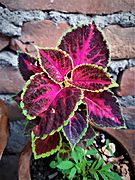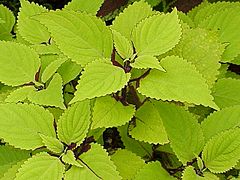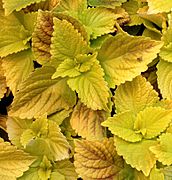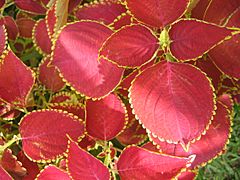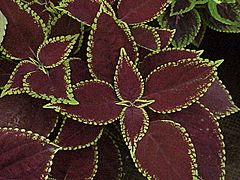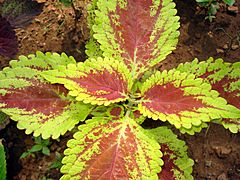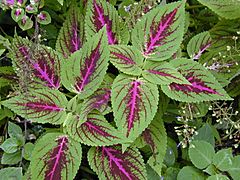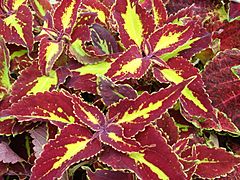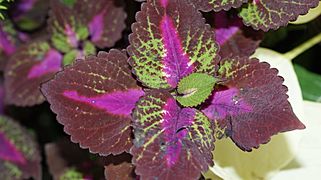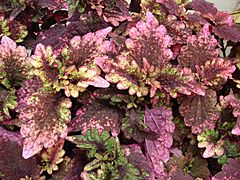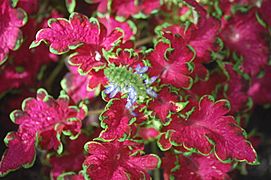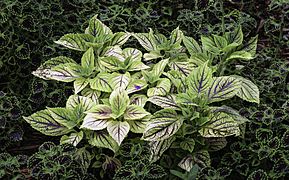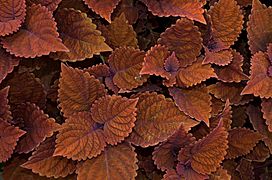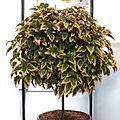Coleus facts for kids
Quick facts for kids Coleus |
|
|---|---|
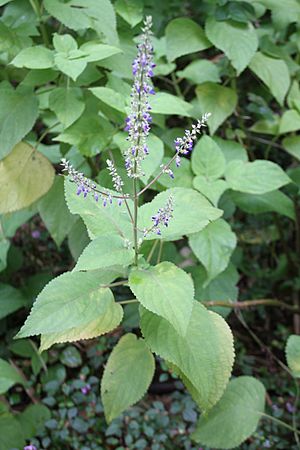 |
|
| Naturalized in Puerto Rico | |
| Scientific classification | |
| Genus: |
Coleus
|
| Species: |
scutellarioides
|
| Synonyms | |
|
|
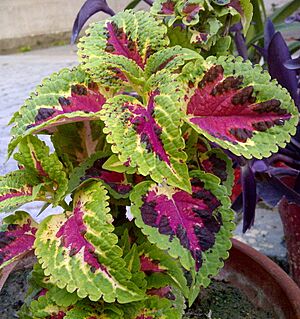
Coleus scutellarioides, often just called coleus, is a beautiful species of flowering plant. It belongs to the Lamiaceae family, which is also known as the mint family. This plant originally comes from places like Southeast Asia and Australia.
Coleus plants usually grow to be about 60 to 75 centimeters (about 2 to 2.5 feet) tall and wide. They are bushy plants that stay green all year round. People love growing them because of their amazing, colorful leaves. Another common name for this plant is painted nettle, which shows its connection to other plants in the mint family like deadnettles.
Some older names for this plant that you might still hear are Coleus blumei, Plectranthus scutellarioides and Solenostemon scutellarioides.
Contents
About Coleus Plants
Coleus plants can grow as annuals (meaning they live for one year) or as short-lived perennials (meaning they live for a few years). They can reach up to 1 meter (about 3 feet) tall and have many branches with square-shaped stems. Some types are shorter and trail along the ground, but they are all still considered Coleus scutellarioides.
The leaves of coleus plants are very different in their colors and shapes. They are a bit thick and can be from 1.5 to 10 centimeters (about 0.6 to 4 inches) long and 1 to 6 centimeters (about 0.4 to 2.4 inches) wide. They are usually oval-shaped and grow on stalks that are 0.5 to 5 centimeters (about 0.2 to 2 inches) long. The edges of the leaves can be smooth or have different levels of cuts or teeth. Both sides of the leaves have small hairs.
Coleus plants also have flowers that grow at the end of their stems. These flower clusters can be up to 4 centimeters (about 1.6 inches) long and have a few or many flowers. The flowers are bluish-purple and shaped like two lips, which is common for plants in the mint family. They are about 8 to 10 millimeters (about 0.3 to 0.4 inches) long. After the flowers, small black fruits form, which are about 1 millimeter long.
Why Coleus Leaves Are So Colorful
The amazing colors you see in coleus leaves come from special pigments.
- Green colors are from chlorophyll. This is the pigment that helps plants make their own food using sunlight (a process called photosynthesis).
- Red, purple, pink, and orange colors come from pigments called anthocyanins. These are like natural dyes found inside the plant cells.
When a coleus plant makes more anthocyanins, it usually makes less chlorophyll. The amount of light a plant gets affects these colors. More light often means more anthocyanins are made, leading to brighter reds and purples. Anthocyanins also help protect the leaves from strong sunlight, especially from harmful ultraviolet light. Sometimes, coleus plants make so many anthocyanins and so little chlorophyll that it can make it harder for them to grow their best.
Naming Coleus Plants
The coleus plant was first described by a famous scientist named Carl Linnaeus in 1763. He called it Ocimum scutellarioides. The word scutellarioides means "looks like the plant Scutellaria", which is another plant in the same family.
Over time, scientists moved this plant into different groups or "genera." In 1830, George Bentham placed it in the genus Coleus, calling it Coleus scutellarioides. He also described another plant, Coleus blumei, which we now know is just a type of Coleus scutellarioides. This is why many gardeners still call the plant "coleus." Later, it was moved to the genus Solenostemon.
Recently, in 2018, a big study looked at how different plant groups are related. This study showed that many plants previously called Plectranthus should actually be called Coleus again. So, Coleus scutellarioides is now officially back in the Coleus group!
Where Coleus Grows Naturally
Coleus scutellarioides is native to a wide area, from Southeast Asia all the way to Australia. This includes many countries and islands like Cambodia, China, Indonesia, Malaysia, the Philippines, Thailand, and parts of Australia.
People grow coleus all over the world, and it has even started growing wild in other warm, tropical places. In its natural home, it grows in areas from about 100 to 1600 meters (about 330 to 5250 feet) high. It flowers and produces fruit all year long in these warm climates. Coleus plants can survive winters only in very warm areas, like USDA Zones 10–11, where temperatures rarely drop below freezing.
Growing Coleus Plants
History of Growing Coleus
The coleus plant was first brought to Europe from Java in 1851 by a gardener from the Netherlands. Back then, there weren't many different leaf colors or shapes. By 1877, there were more varieties, and you could even buy seeds for them. However, early growers accidentally made plants that flowered too soon and had less intense leaf colors.
Growing coleus became popular again in the 1940s. By the 1980s, with better types available, coleus became one of the most important plants grown for gardens in the US. More recently, people have found ways to grow new types of coleus from cuttings, which allows for even more amazing leaf colors and shapes. Now, you can find coleus plants that grow upright or trail along the ground.
Types of Coleus (Cultivars)
The leaves of different coleus cultivars (types created by growers) often have very strong color differences. A single leaf might have several shades of green, pink, yellow, "black" (which is a very dark purple), maroon, cream, white, and red. They can look a bit like another colorful plant called Caladium.
The shape of the leaves also changes a lot. They can be broadly oval or more narrow and pointed. The edges of the leaves might have small or large teeth, or they can be wavy. New types of coleus with different leaf shapes and color mixes are always being created!
- Variation in leaf color and shape in cultivars
Here are some popular types of coleus that have won awards for being great garden plants:
- 'Black Prince'
- 'China Rose'
- 'Combat'
- 'Crimson Ruffles'
- 'Gay's Delight'
- Henna = 'Balcenna'
- 'Juliet Quartermain'
- 'Lord Falmouth'
- 'Picturatus'
- 'Pineapple Beauty'
- 'Pineapplette'
- 'Pink Chaos'
- Redhead = 'Uf0646'
- 'Roy Pedley'
- 'Royal Scot'
- Trusty Rusty = 'Uf06419'
- 'Walter Turner'
- 'Winsome'
- 'Wisley Tapestry'
How to Care for Coleus
When you grow coleus, they like soil that is moist but also drains water well. They usually grow to be about 0.5 to 1 meter (about 1.6 to 3.3 feet) tall, but some can reach up to 2 meters (about 6.6 feet). Coleus plants are grown because they are beautiful ornamental plants.
They can handle heat well. In very hot, sunny places, their colors are often brighter if they are in the shade rather than full sun. They also need less water in the shade. In places where it doesn't freeze, you can keep coleus plants alive for several years if you take good care of them. But in colder areas, people usually grow them as annuals because they can't survive the cold and can get leggy (long and sparse) as they get older.
Coleus also make great houseplants that don't need a lot of fuss. You can easily grow new plants by cutting a piece of stem just below the leaves and putting it in water. The stem will grow roots! If you want your plant to stay bushy, you can pinch off the small flower buds when they appear.
How to Grow New Coleus Plants
There are two main ways to grow new coleus plants:
- From Seeds: Coleus seeds are cheap and easy to find. However, if you grow a named type of coleus from seed, the new plants might not look exactly like the parent plant. To plant seeds, just sprinkle them on top of the soil and gently press them down. Seeds need light to sprout, so don't cover them with soil. Keep the soil moist by covering the container with plastic or misting the seeds every day. You might see the first colors on the tiny sprouts in as little as two weeks!
- From Cuttings: You can also take cuttings from a coleus plant. Cuttings grow roots very easily in plain water, even without special rooting chemicals.
Plant Problems
Like all plants, coleus can sometimes get sick.
- A disease called downy mildew can make the leaves turn brownish and cause them to curl or twist. This mildew is harder to control on the stems than on the leaves.
- Another problem is called impatiens necrotic spot virus. This virus causes brown or yellow spots on the leaves, rings, dark stem colors, and brown leaf veins. Sadly, it can cause the plant to die. Tiny insects called thrips spread this virus from sick plants to healthy ones. Just a few thrips can infect many plants in a greenhouse.
Psychoactive Properties
Some reports suggest that Coleus scutellarioides, sometimes called Coleus blumei, might have very mild relaxing effects if consumed. Scientists have not studied these effects in great detail. However, it is known that the Mazatec people in southern Mexico have used this plant for its mind-altering effects in traditional practices.
Images for kids


